자연은 이미 답을 알고 있다 RISD 네이처랩 소장 제니퍼 비소넷
Nature Already Has the Answer Jennifer Bissonnette, RISD Nature LAB
ABOUT THE INTERVIEWEE 제니퍼 비소넷
로드아일랜드디자인스쿨 네이처랩 소장. 자연과학 지식과 방법론을 예술, 디자인 싱킹 및 스튜디오 실습과 융합하기 위해 다학제적인 기술을 활용한다. 지속가능성과 재생가능성에 초점을 맞춘 디자인을 연구하고 있다.
ABOUT THE INTERVIEWEE Jennifer Bissonnette
Jennifer Bissonnette is currently the Interim Director of RISD’s Nature Lab. Her work engages techniques of transdisciplinary inquiry to merge natural sciences knowledge and methods with art/design thinking and studio practice, with a focus on sustainable and regenerative design.
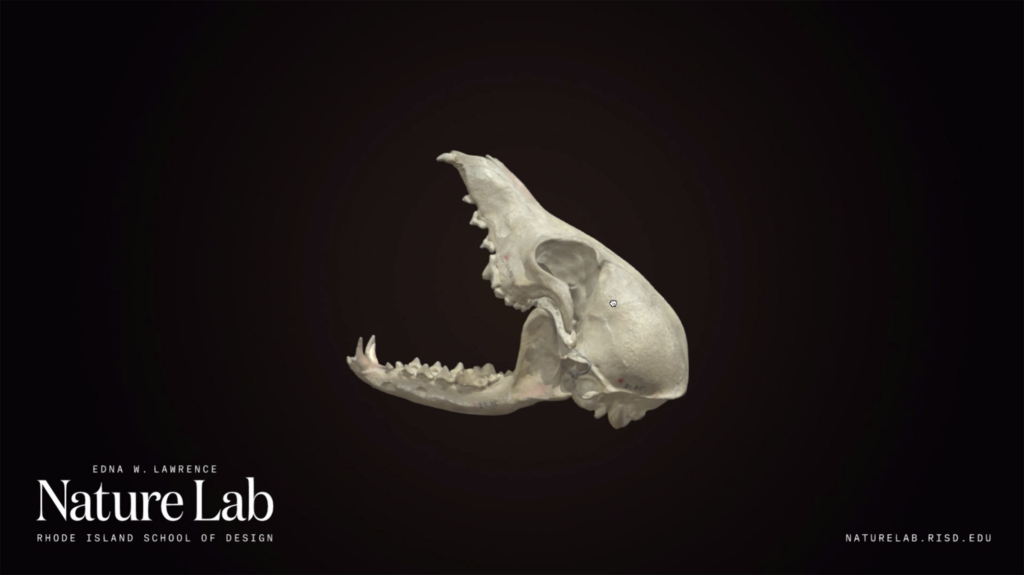
38억 년 치 연구가 축적된 데이터가 있다. 바로 자연이다. 디자인에 영감과 근거를 주는, 이보다 더 좋은 보고가 또 있을까? 1877년 설립한 미국 최초의 예술 대학 중 하나인 로드아일랜드디자인스쿨(RISD)의 네이처랩의 생각도 그랬다. RISD의 네이처랩은 1937년 조개, 나비 등 1286개체의 자연사 컬렉션으로 시작한 이래 오늘날 8만 개가 넘는 표본을 소장하고 있다. 나노 규모에서 실물 크기의 다양한 물체와 자연 생명체의 표본을 직접 만지고 탐구하며 발견하려는 것은 결국 자연 속 디자인의 경이로움과 복잡성이다. 8년째 네이처랩의 수장으로 연구를 이끌어가는 제니퍼 비소넷Jennifer Bissonnette 교수는 말한다. “38억 년 동안 무수한 도전을 받으며 발달한 산물인 자연계에는 우리가 생각해낼 수 있는 그 어떤 디자인도 이미 존재한다고 볼 수 있습니다.” 생물학과 해양 과학을 전공한 과학도 출신의 이 디자인 연구자는 자연의 생체모방 원리를 인간의 주거 환경과 일상, 문화에 적용하는 방법에 주목해왔다. 그는 이러한 디자인을 통해 우리가 직면한 문제를 해결할 뿐 아니라, 훨씬 더 나은 삶의 방식을 발견함으로써 지속가능한 공존을 모색할 수 있다고 믿는다.
Nature has accumulated 3.8 billion years of research on how to live well on this planet. Is there any better inspiration or basis for design? That is what the Nature Lab at the Rhode Island School of Design (RISD), one of the first American art schools that was established in 1877, believe. Founded in 1937 with a collection of 1,286 natural history items, RISD’s Nature Lab now houses more than 80,000 specimens, from extensive holdings of shellfish and butterfly species to a pair of black bears. While touching and exploring various objects and specimens of natural life forms in different sizes, ranging from nano-scale to life-size, what researchers are trying to discover is ultimately the wonder and complexity of design in nature. The current head of Nature Lab, Professor Jennifer Bissonnette says, “In the natural world, which has developed over 3.8 billion years of countless challenges, there are already so many more exceptional iterations of design than we could possibly come up with our own minds.” A design researcher with degrees in biology and marine science, she pays attention to how to apply the principles of biomimicry to the human built environment, daily life and culture. She says this approach to design not only offers solutions to the problems we currently face, but also suggests a much better way of life, enabling the exploration of sustainable coexistence.
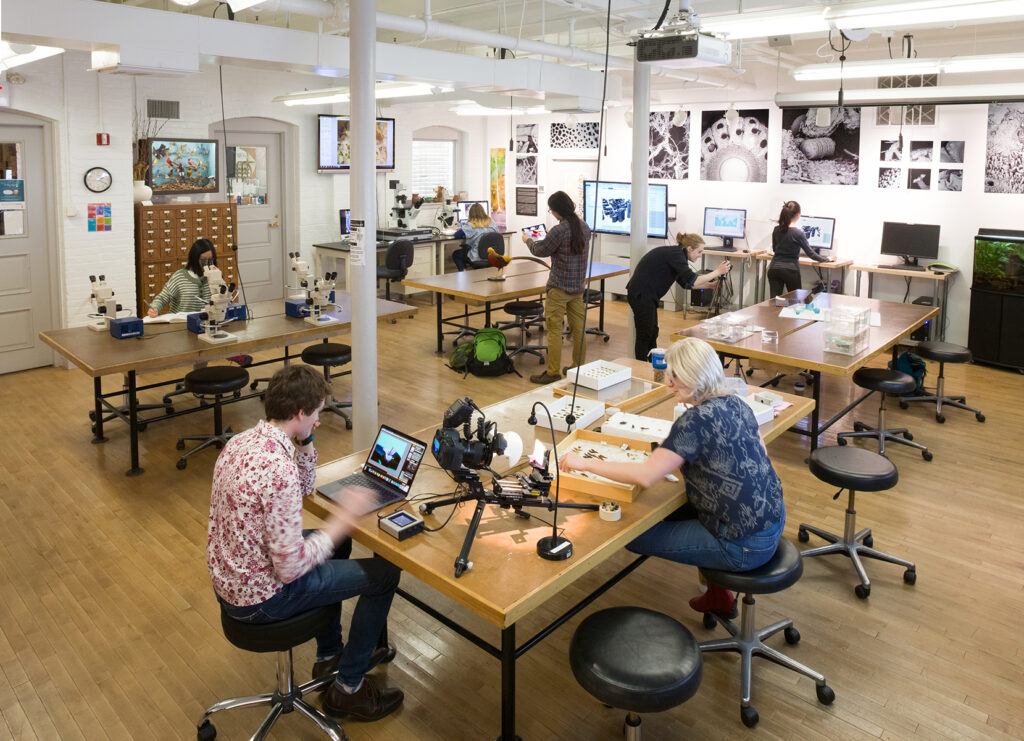
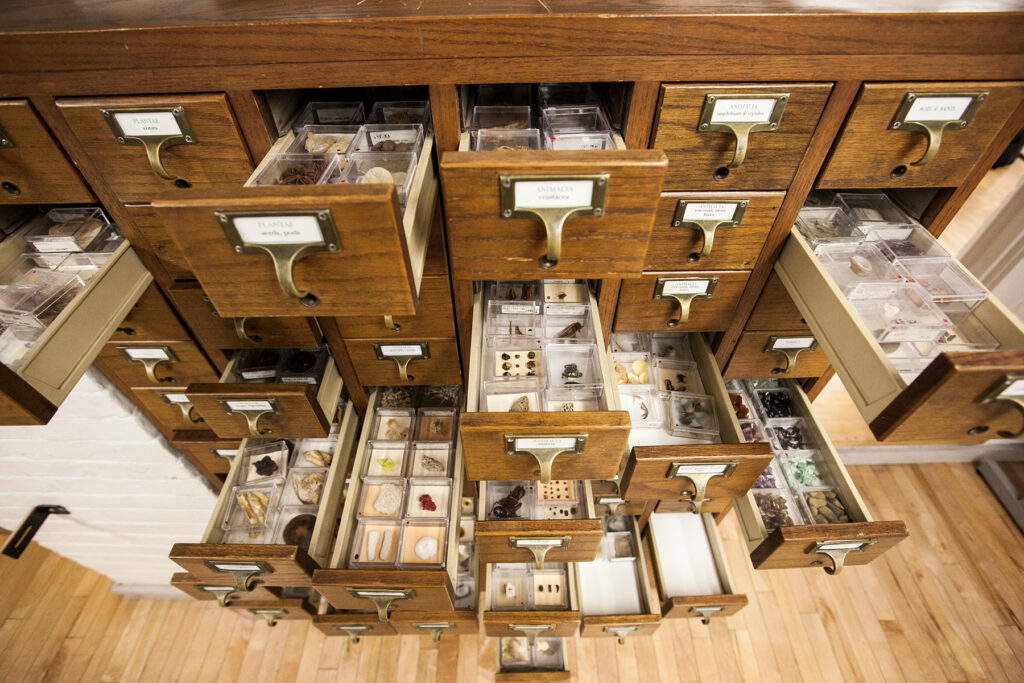
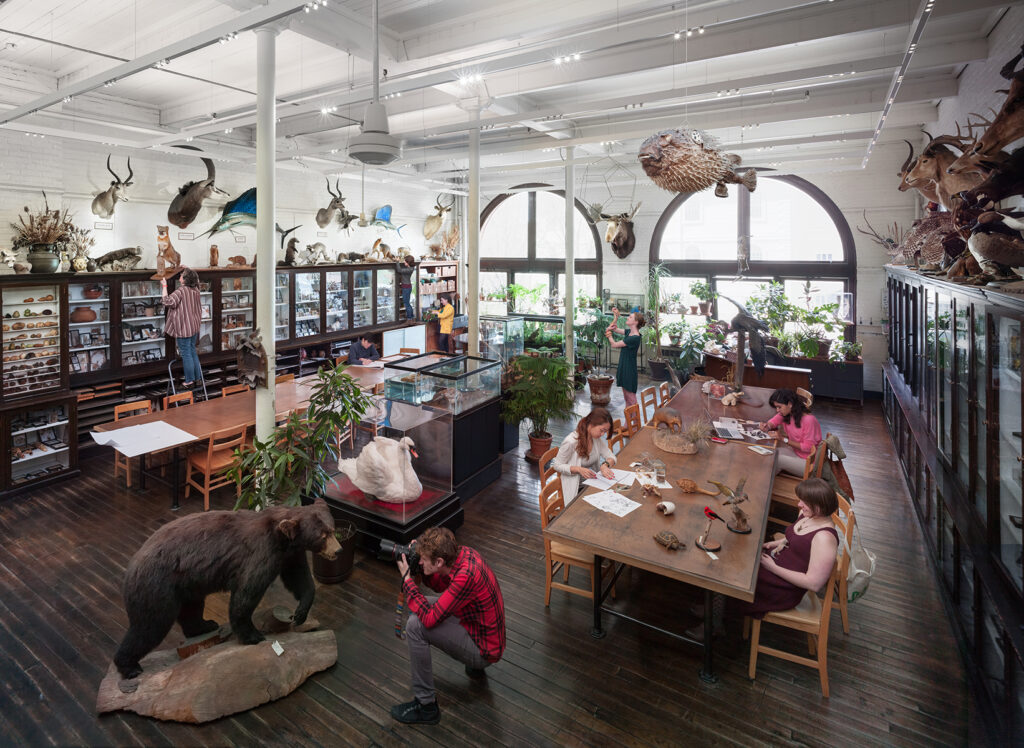
Q1.
최근 네이처랩에 84㎡ 규모로 ‘바이오디자인 메이커스 스페이스’를 조성했다. 인근만의 물고기와 무척추동물이 있는 대형 해수 탱크, 지역 강 유역을 상감으로 표현한 테이블을 비롯해 다양한 지속가능성을 담은 재료로 꾸민 공간이다. 디자이너는 여기서 어떤 영감을 받을 수 있나?
이곳은 지속가능하고 생체친화적인 디자인 원칙을 선보여 생체 모방에 대한 영감과 지역 생태계 내에서 우리 인간의 위치 감각을 상기시키는 공간이다. 자연 시스템의 작동 방식을 이해하고 이를 디자인에 활용하는 게 목적이다. 이를테면, 이곳에는 3개의 다른 아쿠아포닉이 있다. 아쿠아포닉은 물고기양식과 수경재배를 융합한 기술로 물고기를 키운 물을 순환해 식물까지 키우는 양식 시스템이다. 우리는 탱크 속 물고기에게 먹이를 주고, 이들이 만드는 배설물이나 기타 찌꺼기가 다시 박테리아로 분해되어 식물이 자랄 수 있는 영양분이 담긴 구성 요소로 바뀌는 과정을 관찰할 수 있다. 이를 통해 도시 환경에서 최소한의 생태 발자국으로 식량 문제를 해결하는 디자인은 무엇인지 탐구할 수 있다. 식용 물고기를 키우는 동시에 그 물고기가 생산한 부산물을 토대로 역시 먹을 수 있는 식물을 기른다면, 도심 속 인구가 이 기둥 모양의 물탱크 하나로 식량 문제를 해결할 수 있다는 생각에 도달할 수 있다. 이런 접근법은 문제를 해결하는 방식을 고안하는 데 자연이 늘 함께한다는 개념을 심어주는 역할을 한다.
Q1.
We know that Nature Lab formed Biodesign Makers’ Space on an 84㎡ (900ft²) area recently. Two large-sized saltwater tanks are filled with fish and invertebrates from the nearby bay, the tables are inlaid with the contours of local rivers in our watershed, and sustainable materials are used whenever possible. What kind of inspiration can designers derive from here?
This place is dedicated to showcasing and fostering the principles of sustainable, biophilic design, as well as providing inspiration for applied biomimicry and a sense of our place in local ecosystems. It aims to help us understand how natural systems work and employ them in our designs. For example, we have three different types of aquaponics (a food production system that couples aquaculture with hydroponics), allowing us to observe the process in which we feed the fish in the tank and the waste of the fish is broken down by bacteria into the building blocks/nutrients plants need to grow. We can then start talking about what it means to use design to create excellent opportunities for growing food in an urban environment, and leaving a very small ecological footprint at the same time. Growing edible fish while also growing edible plants based on the by-products produced by the fish, in a very small space, can help solve the problem of providing food for urban populations such an approach provides us with an opportunity to work with nature, and create solutions to some of our most pressing problems.
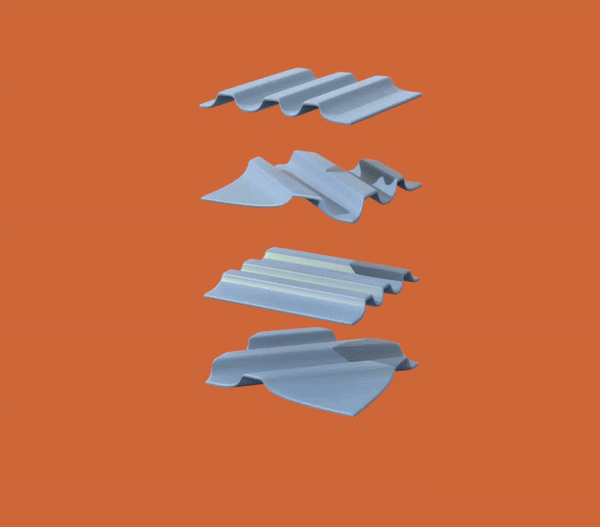
Q2.
자연은 크고 작은 단순성이 결합한 놀라운 복잡계이자, 수많은 우연과 경우의 수를 지닌 변화 그 자체다. 기아는 이런 특성이 빚는 디자인을 ‘자연과 조화되는 대담함’이라 부른다. 네이처랩에서 자연의 원리를 디자인에 접목하는 과정이 궁금하다. 특정한 과학적 발견에서 디자인 원리를 어떻게 도출하는가?
우리는 끊임없이 자연을 모방하며 문제를 해결한다. 보통은 자연을 바라보다 무엇을 만든다기보다, 잘 풀리지 않는 디자인적 문제에 몰두하다 자연을 들여다보게 된다. 자연 속 개체들이 어떻게 자신을 보호하고, 소리를 만들며, 방음 역할을 구축하는지 등등 말이다. 보호 측면에서 예를 들자면, 계란의 껍데기나 콩의 꼬투리, 둥근 고리 모양을 등 뒤에 단 생명체의 형태 등을 생각해볼 수 있다. 즉 첫 번째 단계는 집중하고자 하는 부분을 자연 세계에서 간추려 가는 방법을 다양한 생명체를 관찰하며 모색하는 것이다. 이후에는 지속해서 깊이를 넘나드는 탐구 과정을 반복한다. 때에 따라 디자인의 기능을 수행하는 것은 형태가 될 수도 있고, 과정이나 행동일 수도 있다. 이런 과정을 거치다 보면, 그간 가정이나 추정에만 머물렀던 지점이 명료해지며 더 깊은 이해를 위하여 과학자에게 물어보고 싶은 구체적인 질문이 생기기도 한다. 이를 통해 우리는 관찰에서 얻은 초기 영감을 넘어 과학을 디자인으로 효과적으로 번역할 수 있게 된다.
Q2.
Nature is a marvelously complex system. It combines both small and large simplicity, and it changes itself with numerous coincidences and cases. Kia calls the design concept created by these characteristics ‘Bold for Nature.’ Through numerous experiments conducted by Nature Lab, I am curious about the specific process of applying the principles of nature into design. How do you drive design principles from certain scientific discoveries?
We constantly try to solve the problem by following the process of biomimicry. Typically, you identify your design challenges, and then you look to see how nature has solved similar challenges. For example, you might ask: how does nature carry out protection? how does nature create sound? how does nature keep sound from being too loud? In terms of protection, you might look at the structure of an egg, a seed pod, or the armoring of a certain creature. In other words, the first step is to ask your question of biologiy, and then look at various creatures and find ways to abstract the strategies they use to meet the design challenge After that, we try to emulate the strategy in our own design applications, usually iterating many times in the process, always going back to the underlying science. Sometimes it’s about structure that performs the function of design. Sometimes, it can be a form, a process, or a behavior. As you go through this process, assumptions become clearer and you may have specific questions that you want to ask scientists for a deeper understanding. Through this, we come to go beyond just initial inspiration from our observations to effective translation of the science into design.
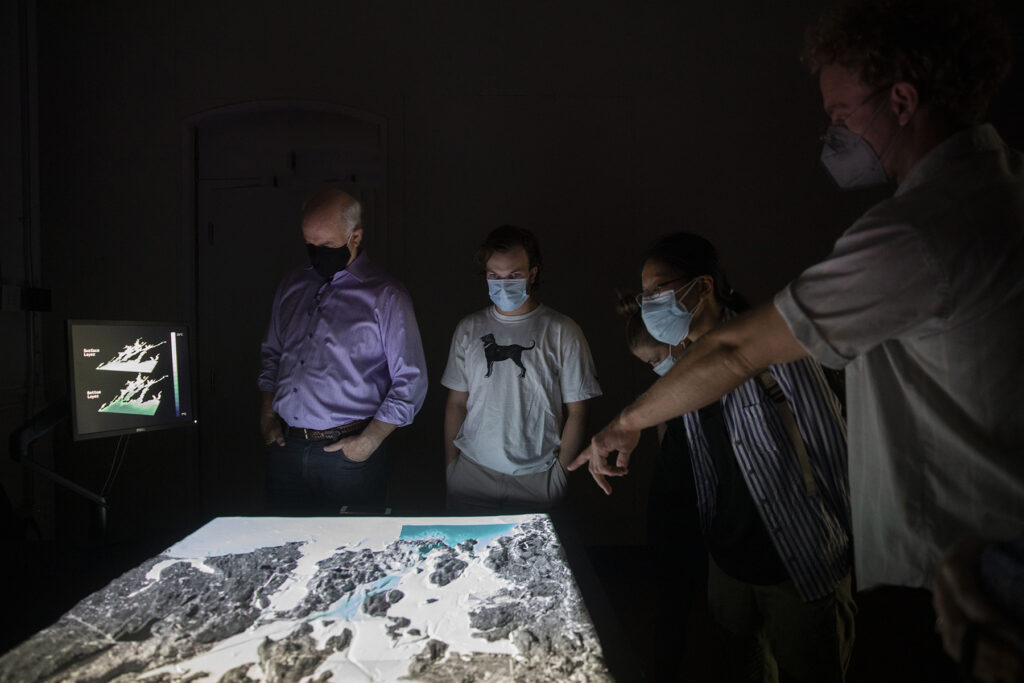
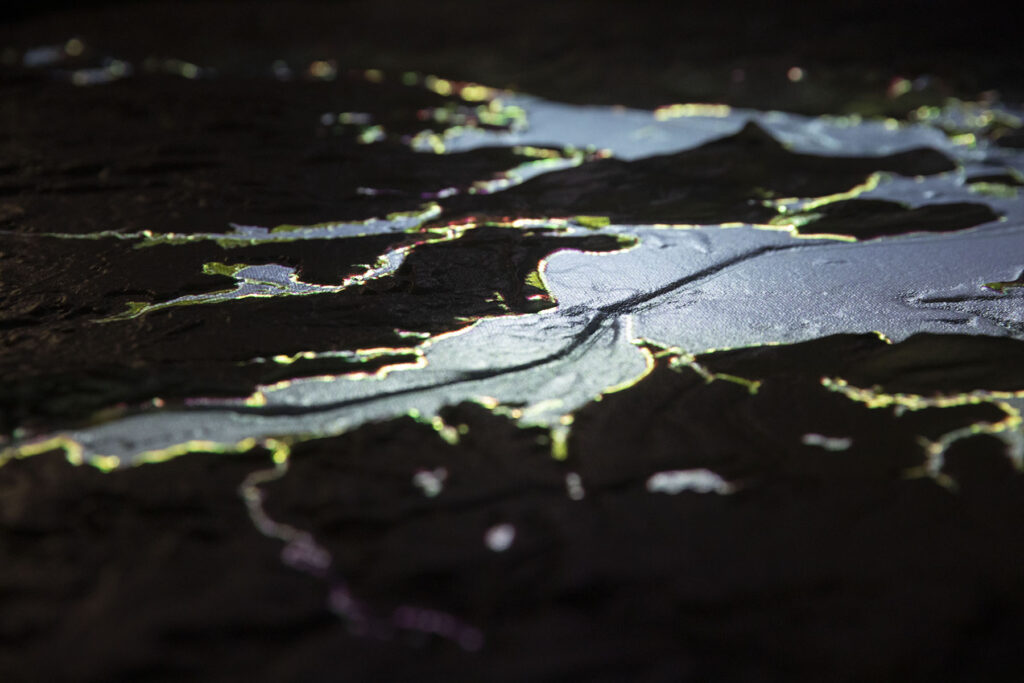
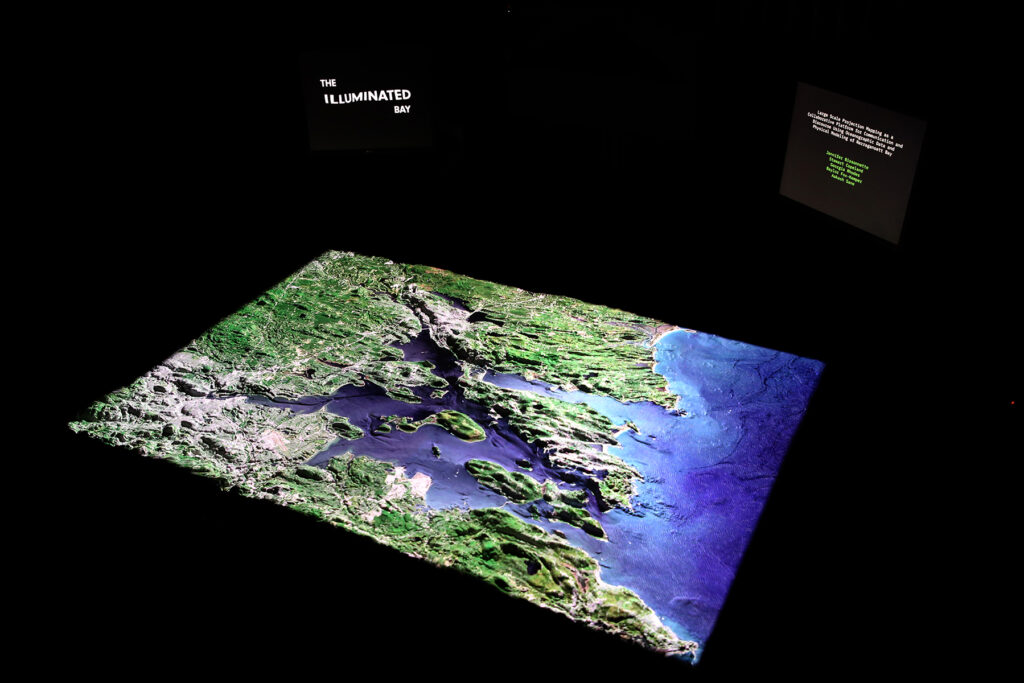
Q3.
기아의 새로운 디자인 철학인 ‘상반된 개념의 창의적 융합(OU)’은 상반되게 보이는 두 지점이 만든 균열이 빚어내는 가장 균형적인 디자인을 추구한다. 즉, ‘다름’에서 오는 불확실성이나 긴장감을 긍정적인 창조의 원천으로 바라보는 것이다. OU에 대한 설명을 듣고 즉각적으로 떠오르는 자연 속 이미지나 개념이 있나?
나는 생태계와 같은 ‘시스템’을 기반으로 많은 연구를 하기에, 어떠한 두 성질이 ‘반대된다’는 개념조차 매우 흥미롭다. 서로 다른 힘을 통합하는 게 자연 생태계의 특성이기 때문이다. 시스템은 다양한 입력 정보로 이루어지고, 이 정보를 서로 동화하거나 수용하도록 진화하는 역학이 곧 시스템을 정의한다. 시스템에는 늘 긴장을 유발하는 진화가 존재한다. 현재 무리 없이 잘 작동하는 것과 외부의 힘을 빌려 더 나은 적응을 유발하는 것의 끊임없는 반복이다. 그렇기에 내가 자연을 떠올렸을 때 떠오르는 첫 번째 이미지는 에코톤이다. 생태학에서 에코톤이란 두 개의 상이한 서식지가 만날 때 자연적으로 형성되는 중간 지대를 뜻한다. 이를테면 고지대와 바다 사이의 소금 습지를 들 수 있다. 식물이 우거진 고지대의 초목 환경과 물이 있는 저지대의 해양 환경이 맞닿는 지점이다. 명백하게 다른 생명체를 품고 있는 두 환경이 중첩하는 공간이 곧 에코톤이다. 여기에는 양쪽에서 온 종들이 모여 매우 비옥하고 풍부한 특성을 갖추며, 종국에는 에코톤에만 서식하는 동식물종까지 나타난다. 삶의 에너지로 가득 찬 염습지는 전 지구에서 가장 생산적인 생태계 중 하나이기도 하다.
Q3.
Kia’s new design philosophy “Opposites United” (OU) is short for “Creative Convergence of Opposite Concepts.” It seeks the most balanced design created by the cracks created by two seemingly contradictory points. The uncertainty or tension that comes from different things is viewed as a positive source of creation. What is an image or concept in nature that comes to your mind immediately as you hear this concept?
Because I work so much in systems, to me even the notion of “opposites” is an interesting concept, as it’s the nature of systems to integrate disparate forces. You have a variety of inputs, and the dynamics that evolve to assimilate or accommodate those inputs define the system. There is always tension driving evolution, a never-ending iteration between what works now, and how to accommodate external forces and change to better adapt. That said, the first image from nature that came to mind is an ecotone. In ecology, this is the space between two very different environments, something that naturally arises when two different habitats meet. For example, salt marshes often occur between the upland and the sea. It is the point where the upland’s vegetative environment and the lowland’s marine environment with water meet. The two environments with obviously very different creatures overlap in the ecotone. Species from both sides are gathered here, and the area is very fertile and rich with nutrients. There are also species that can only exist in that space. Salt marshes, which are full of life energy, are one of the most productive ecosystems on the planet.
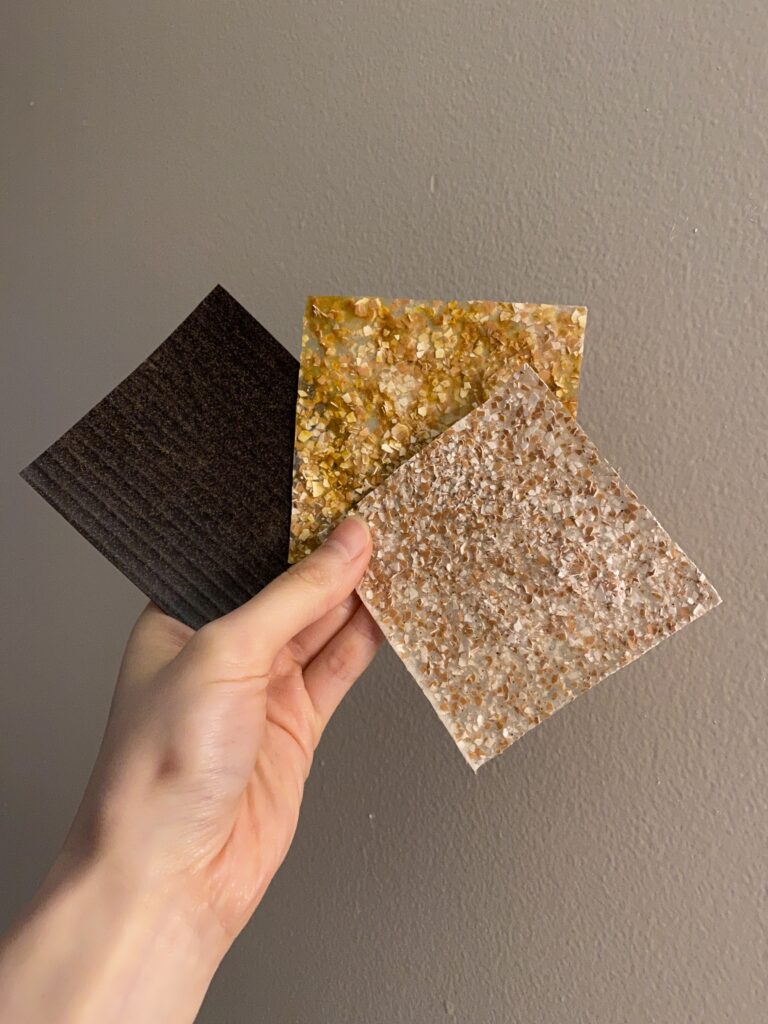
Q4.
이성적이고 논리적인 사고는 흔히 감성을 저해한다고 여겨진다. 그러나 기아가 생각하는 좋은 디자인은 존재와 형태의 이유가 명확한 ‘이유 있는 즐거운 경험’을 추구한다. 네이처랩 또한 화학, 생물학, 식물학에서 GIS 맵핑에 이르기까지 복잡한 과학적 원리를 바탕으로 디자인의 근거를 탐구한다. 이러한 ‘이유 있는 디자인’이 중요한 이유는 무엇인가?
나는 기아의 이 원칙이 특히 마음에 와닿는다. 이성과 기쁨 모두 근본적으로 매우 중요한 디자인 요소이며, 우아하고 효과적으로 난관에 대응하면서 동시에 인간의 영혼을 채우는 디자인이 필요하다는 사실을 상기시키기 때문이다. 이는 효율성뿐 아니라 세상이 어떻게 변화하길 바라는 마음과 가치에 관한 것으로 생각한다. 인간의 심리는 ‘이야기’를 따르며, 그게 어떤 맥락에 속하는지 이해하기를 원한다. 자연과 더불어 하는 디자인은 다른 생명체와 연결되고자 하는 우리의 본질적인 욕구를 충족시키며, 과학적 원리를 진정 이해하고 충실히 적용할 때 온전하게 달성할 수 있다. 이는 내가 종종 말하는 ‘똑똑한 디자인’과 ‘현명한 디자인’의 차이이기도 하다. 똑똑한 디자인은 보기에만 그럴듯한 피상적인 방법이나 최소한으로 환경적 책임을 지는 디자인이다. 반면 현명한 디자인은 환경에 나쁜 영향을 주지 않는 걸 넘어 더 나은 상황을 위한 솔루션까지 이야기한다. ‘문제 해결 과정에서 토지를 재생할 수 있는가, 물을 더 깨끗하게 정화할 수 있는가?’ 등을 고민하며 초기 문제 해결뿐 아니라 미래의 다른 문제까지 동시에 내다보는 것이다. 즉, 시스템 전반에 걸쳐 긍정적인 영향을 미치는 디자인 해결책 말이다.
Q4.
Rational and logical thinking are often regarded as an attitude that inhibits emotions. However, a good design that Kia thinks is a design with a clear reason for its existence and form. This is where the design principle of “Joy for Reason” came from. Nature Lab also emphasizes the understanding of complex scientific principles through chemistry, biology, botany, and GIS mapping to explore the rationale for a design. Why does Nature Lab value these “designs for a reason”?
I love this OU principle. Both joy and reason are fundamentally important, and speak to the need for design that responds elegantly and effectively to performance challenges, but that also feeds the human soul. It’s not just about efficiency, it’s about heart, about values, about how we want our world to be. The human psyche wants to understand the story, and wants to understand where it belongs. Designing with nature fills an inherent need for us to connect with our ecosystem and other living beings, and this kind of deep integrity in design can only be achieved by really understanding the science and being faithful to it as we arrive at solutions. It’s the difference between what I call “clever design” and “wise design.” A clever design is a design that addresses a superficial or minimal environmental issue in a way that only appears to be plausible. On the other hand, wise design looks at a deeper understanding of the whole system, and aims for solutions that not only do no harm, but actually do good. It looks at the bigger picture surrounding the initial design challenges by considering questions such as: “Can I also regenerate land in doing this, or can I clean water rather than causing pollution in the problem solving process?” It gets at design solutions that have a series of cascading positive impacts across the system.
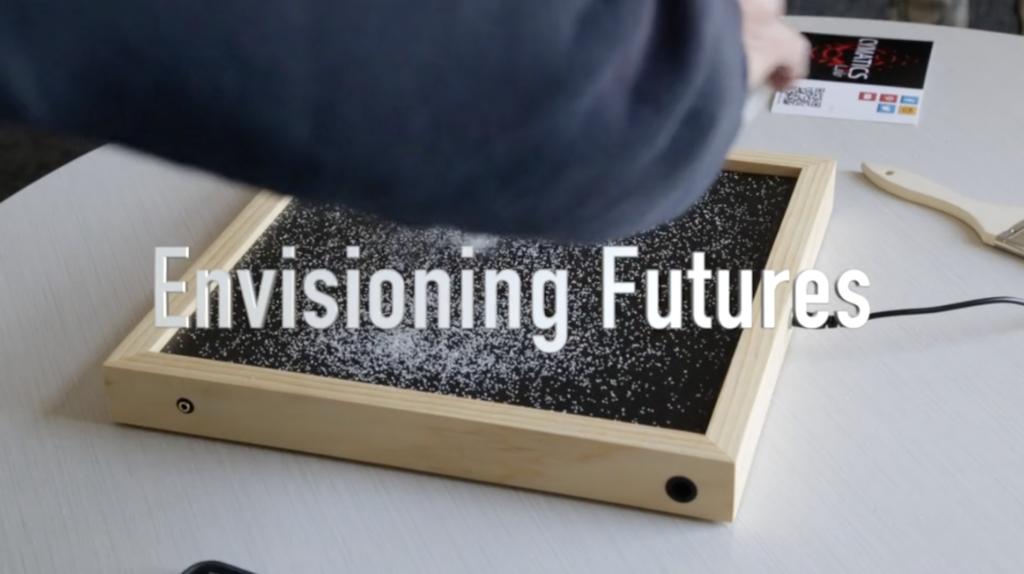
Q5.
오늘날 자연과 인간의 연결성을 기술에까지 불어넣는 방법에 대한 논의가 활발하다. 기아가 중시하는 ‘인간의 삶을 위한 기술’은 궁극적으로 자연, 인간, 기술을 서로 연결하는 가치를 지향한다. 기술에 감성을 불어넣는 방법에 자연이 어떻게 활용될 수 있을까?
RISD 학생들과 현대자동차가 함께 하는 미래 모빌리티와 도시에 대한 콘셉트 연구에서 예시를 찾아볼 수 있을 것 같다. 흔히 ‘생명과 살아있는 존재에 대한 사랑’으로 번역되는 바이오필리아적 디자인 중 하나는 바로 소리다. 자연 속 특정 음향의 리듬이나 패턴은 우리를 편안하게 한다. 스파 시설에서 들을 수 있는 엠비언트 사운드는 물이 흐르는 소리나 새가 지저귀는 소리처럼 방문객을 안정시켜 주는 특성이 있다. 이에 한 학생이 자동차는 보통 외부 소음을 줄이는 방음 기능에 주목하다 보니 이런 치유적인 소리까지도 차단한다는 의견을 내놨다. 만약 운전하며 지나가는 그 지역 고유의 자연 소리를 켤 수 있는 버튼이 있다면 어떨까? 차로 여행하며 단순히 눈으로 경치를 보는 걸 넘어 나를 둘러싼 자연을 귀로도 느끼는 것이다. 보이지 않는 것을 보이게 하고 들리지 않는 걸 들리게 하면 주변에서 일어나는 일을 실시간으로 더 깊이 경험하게 한다. 다른 세계에 있는 다른 존재에 대한 우리의 공감을 불러일으킨다. 이는 자연의 위대함 속에서 때때로 우리 인간이 얼마나 작은 존재가 될 수 있는지 깨닫는 매우 겸허한 경험이기도 하다. 이처럼 소리는 우리가 자연 세계로 들어가는 창을 열어준다.
Q5.
Today, there is an active discussion on how to bring this connection between nature and humans to technology. One of Kia’s design philosophy pillars, “Technology for Life,” ultimately aims at the value of nature-human-technology connections. How can nature be used to connect nature and humans to bring about sensibility to technology?
We do not have to look further than RISD students’ joint research project with Hyundai Motor Company about future mobility and cities. In terms of biophilic (meaning a love of life or living things from the Greek) design, one of the components is sound. There are certain rhythms and patterns in nature that can cause our stress levels to lower, our immune systems to function better, even our cognitive performance to be improved. If you go to a spa, you may have heard these ambient sounds: a babbling brook, and birds singing, for example. They use these sounds to instill a sense of calm. One student pointed out that we are insulating users from such healing sounds by focusing on soundproofing, which reduces outside noise in a car. What if we had a button to hear the sounds of nature of the region while driving a car? We could actually listen to the sounds of nature surrounding us, not just seeing the landscapes while traveling in a car. Projects that flip the invisible into the visible, or the unheard to the heard, can help bring people to a deeper experience of what is happening around them in real time. It can also give us empathy for other beings, as we realize that they are experiencing the world differently than we are. It can be a humbling experience since we realize how small we can sometimes be in the greatness of nature. Such a sound experience allows us a window into the world of nature around us.

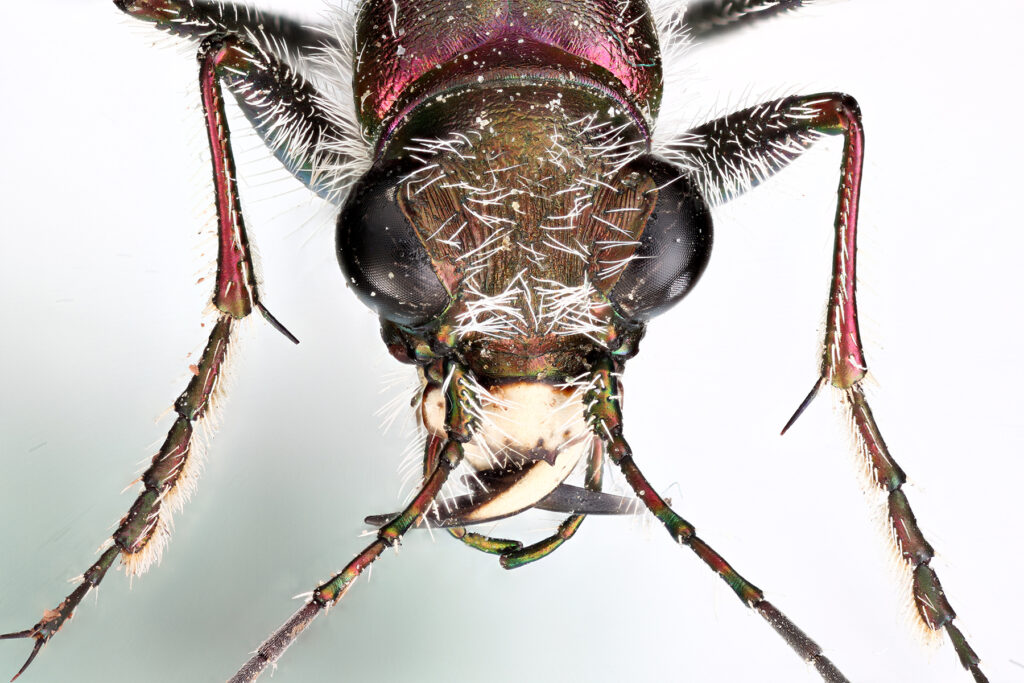
Q6.
장기화 중인 팬데믹은 모든 분야에 팽팽한 긴장을 가져오며 창의력을 발휘하는 계기를 자극하고 있다. 기아가 말하는 ‘평온 속의 긴장감’은 바로 이런 지점에서 디자인 또한 진화한다고 생각한다. 코로나19가 일깨운 인간과 자연과의 관계에서 중요한 변화는 무엇일까?
코로나19는 과연 자연과 우리의 관계를 다시 생각하게 된 계기였다. 개인적으로 인간이 사라진 황량한 거리를 배회하는 야생동물을 찍은 사진이 반가웠고, 활동을 잠시 멈추는 게 지구 오염을 줄이는 데 긍정적인 영향을 미친다는 사실을 깨달았다. 자연의 놀라운 회복력을 보여주는 동시에 우리가 자연을 상대로 일삼아온 영향력에 대한 통찰력을 주었다고 본다. 동시에 자연은 많은 이에게 일종의 피난처가 되었다. 자연이라는 외부 공간은 우리가 마스크를 벗을 수 있는 유일한 장소였다. 자연으로 들어가는 행위가 개개인의 정신 건강에 미치는 이점은 그 어느 때보다 명백했다. 도심 속 공원 등 자연적 피난처는 더는 미적 감각이나 편의 시설, 개인의 웰빙 차원이 아니라 공중 보건 영역에서 다뤄야 할 문제임이 분명해졌다. 인간의 자아와 자연이 직접적으로 연결되는 경험은 자연을 개인적인 문제로 인식시켜 사람들이 환경친화적인 행동을 도모하는 강력한 동기를 부여했다. 지속가능한 생태계를 위해서는 여전히 더 많은 이가 활동에 나서야 한다. 많은 사람이 자연과 연결되어 이런 변화를 만들어내길 바란다.
Q6.
The prolonged pandemic brought tension in all fields, while also stimulating an opportunity to show creativity. Among the five pillars of OU, “Tension for Serenity” is the view that design evolves in this tension. What do you think is the important change in the relationship between humans and nature that Corona has awakened?
The COVID-19 situation has definitely been a time of reconsidering our relationship with nature. I loved all of the images of wildlife wandering into our deserted streets, and took heart, as many did, at the positive effect our pause in activity was having on decreasing pollution. It simultaneously gave us some insight into the amazing resilience of nature and the impact we’ve been having on nature. Nature also became such a refuge for so many who were outside—the one place we could leave behind our masks—and the mental health benefits of getting out in nature became clearly apparent on a very personal level. It became evident that areas of natural refuge like parks in the city center are not just a matter of aesthetics or amenities, or even the opportunity for individuals to improve their health and wellbeing, but truly a matter of public health. These kinds of direct experiences of a connection to nature, an integration of nature into a person’s sense of self-concept, have helped to motivate pro-environment behavior. We need greater numbers of people getting behind sustainability actions and hopefully more people connecting with nature will fuel that change.
진행·정리 김은아
프리랜스 에디터. 《매거진B》, 《월간 디자인》에서 일하며 국내외 동시대 크리에이티브를 관찰하고 예술가, 건축가, 디자이너, 기업가 등을 인터뷰했다.
Interview & Story Eunah Kim
Kim is a freelance editor. She has observed contemporary creators in different fields, and interviewed artists, architects, designers, and businesspeople while working for Magazine B and Design magazine.